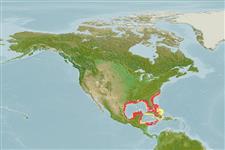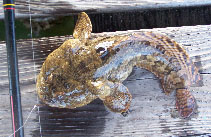Adicionar as suas observações no Fish Watcher
| Native range | All suitable habitat | Point map | Year 2050 |

|
| This map was computer-generated and has not yet been reviewed. |
| Opsanus beta AquaMaps Data sources: GBIF OBIS |
Adicionar o seu Fotografias e vídeos
Pictures | Sounds | Imagem do GoogleOpsanus beta
Picture by Reid, R.
Pictures | Sounds | Imagem do GoogleOpsanus beta
Picture by Reid, R.
Classificação / Names Nomes comuns | Sinónimos | Catalog of Fishes(Género, Espécies) | ITIS | CoL | WoRMS | Cloffa
> Batrachoidiformes (Toadfishes) > Batrachoididae (Toadfishes) > Batrachoidinae
More on authors: Goode & Bean.
More on authors: Goode & Bean.
Environment: milieu / climate zone / depth range / distribution range Ecologia
marinhas demersal. Subtropical; 35°N - 15°N, 98°W - 74°W
Distribuição Países | Áreas FAO | Ecossistemas | Ocorrências | Point map | Introduções | Faunafri
Western Atlantic: Florida (USA), Little Bahama Bank (Bahamas) and the entire Gulf of Mexico to Campeche, Mexico (Ref. 7251). Range extended to Brazil (Ref. 94035).
Length at first maturity / Tamanho / Peso / Idade
Descrição breve Chaves de identificação | Morfologia | Morfometria
Dark brown bars on caudal and pectoral fins; bars on pectoral fin irregularly joined (Ref. 26938).
Commonly found in seagrass beds and rocky cuts in coastal bays and lagoons, and in shallows along open coast. In western coast of Florida, adults spawn in February and March (Ref. 26938). Nesting males produce grunt calls called the boatwhistle as advertisement of competition among males and to attract females (Ref. 45338). Neither opercular nor dorsal gland is venomous (Ref. 57406).
Life cycle and mating behavior Maturidade | Reprodução | Desova | Ovos | Fecundidade | Larvas
Referência principal
Upload your references | Referências | Coordenador : Collette, Bruce B. | Colaboradores
Robins, C.R. and G.C. Ray, 1986. A field guide to Atlantic coast fishes of North America. Houghton Mifflin Company, Boston, U.S.A. 354 p. (Ref. 7251)
Categoria na Lista Vermelha da IUCN (Ref. 130435: Version 2024-2)
Preocupação menor (LC) ; Date assessed: 23 November 2018
CITES
Not Evaluated
Ameaça para o homem
Reports of ciguatera poisoning (Ref. 31174)
Utilização humana
FAO - Publication: search | FishSource |
Mais informação
Population dynamics
Parâmetros de crescimento
Max. ages / sizes
Length-weight rel.
Length-length rel.
Frequência de comprimento
Mass conversion
Recrutamento
Abundância
Parâmetros de crescimento
Max. ages / sizes
Length-weight rel.
Length-length rel.
Frequência de comprimento
Mass conversion
Recrutamento
Abundância
Life cycle
Reprodução
Maturidade
Maturity/Gills rel.
Fecundidade
Desova
Spawning aggregations
Ovos
Desenvolvimento dos ovos
Larvas
Dinâmica larvar
Reprodução
Maturidade
Maturity/Gills rel.
Fecundidade
Desova
Spawning aggregations
Ovos
Desenvolvimento dos ovos
Larvas
Dinâmica larvar
Anatomy
Área branquial
Brain
Otolith
Área branquial
Brain
Otolith
Physiology
Body composition
Nutrients
Consumo de oxigénio
Tipo de natação
Velocidade de natação
Visual pigments
Fish sound
Diseases & Parasites
Toxicity (LC50s)
Body composition
Nutrients
Consumo de oxigénio
Tipo de natação
Velocidade de natação
Visual pigments
Fish sound
Diseases & Parasites
Toxicity (LC50s)
Human related
Aquaculture systems
Perfis para aquacultura
Estirpes
Ciguatera cases
Stamps, coins, misc.
Aquaculture systems
Perfis para aquacultura
Estirpes
Ciguatera cases
Stamps, coins, misc.
Ferramentas
E-book | Guia de campo | Chaves de identificação | Ferramenta auxiliar de frequências de comprimento | Ferramenta sobre a história de vida | Mapa dos pontos | Classification Tree
| Catch-MSY |
Relatórios especiais
Descarregue XML
Fontes da internet
AFORO (otoliths) | Aquatic Commons | BHL | Cloffa | BOLDSystems | Websites from users | Consultar FishWatcher | CISTI | Catalog of Fishes: Género, Espécies | DiscoverLife | ECOTOX | FAO - Publication: search | Faunafri | Fishipedia | Fishtrace | GenBank: genoma, nucleotídeo | GloBI | GoMexSI (interaction data) | Google Books | Google Scholar | Google | IGFA World Record | MitoFish | Bases de dados nacionais | Otolith Atlas of Taiwan Fishes | PubMed | Reef Life Survey | Socotra Atlas | Árvore da vida | Wikipedia: ir para, procurar | World Records Freshwater Fishing | Registo zoológico
Estimates based on models
Preferred temperature (Ref. 123201): 23.3 - 27.9, mean 24.6 °C (based on 316 cells).
Phylogenetic diversity index (Ref. 82804): PD50 = 0.5312 [Uniqueness, from 0.5 = low to 2.0 = high].
Bayesian length-weight: a=0.01175 (0.00850 - 0.01623), b=3.09 (3.00 - 3.18), in cm total length, based on LWR estimates for this species (Ref. 93245).
Nível Trófico (Ref. 69278): 3.7 ±0.6 se; based on size and trophs of closest relatives
Generation time: 5.0 ( na - na) years. Estimated as median ln(3)/K based on 1 growth studies.
Resiliência (Ref. 120179): Médio, tempo mínimo de duplicação da população 1,4 - 4,4 anos (K=0.218; tm=1+).
Fishing Vulnerability (Ref. 59153): Moderate vulnerability (38 of 100).




